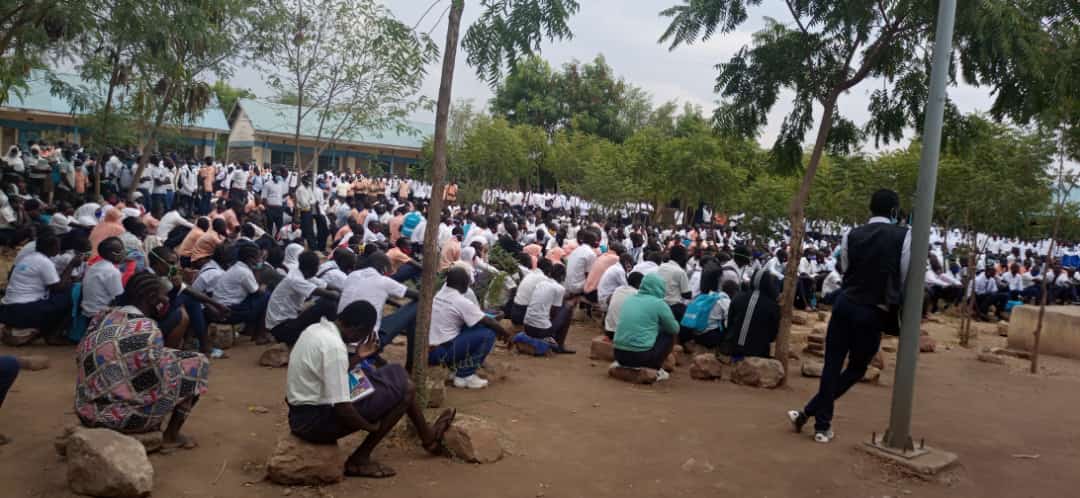Baluu Wol Makuach – KANERE Staff Writer, February 2021
Kenya announced its first Covid-19 case on March 13th 2020 when a woman contracted the virus upon her return to Kenya after traveling to the United States via London.

Two days later, President Uhuru Kenya announced a nationwide school lockdown after two new Covid-19 cases were confirmed in the country.
On March 16th 2020, all schools were shut down in Kakuma Refugee Camp.
Seven months later, on October 6th 2020, after the shutdown of schools across Kenya, the Education Cabinet Secretary, George Magoha, announced a phased reopening of schools for Competency-Based Curriculum Classes, Grade 4, Class 8, and Form 4 learners.
Kakuma Refugee Camp prepared for the phased reopening of schools under new COVID-19 containment protocols and guidelines. According to the Deputy Headmaster of Kadugli Primary School Mr. Lubarak Darius, Lutheran World Federation (LWF) has distributed face masks, handwashing tanks, and soaps to support the reopening of the schools.
A statement issued by the Education Ministry states that Form 4 and Class 8 will start their KCPE exams on March 22nd 2021 and end on March 24th2021, while KCSE exams will start on March 25th 2021 and end on April 16th 2021.
KANERE interviewed a popular principal in Kakuma Refugee Secondary School (KRSS), Mr. Stanley Kioko, who said that schools in Kakuma had to come up with strategies to ensure that students were able to continue studying at home during the school lockdown period. “On the issue of the COVID-19 pandemic, when the schools were closed on March 16th, the school in the camp came up with some intervention for our students. One of the measures we put in place from March to September was online teaching. We prepared a timetable and tried to collect the data from the students,” he said.
The schools launched WhatsApp-based and radio-based learning programs to help students continue learning after the definite closure of the schools in Kakuma due to the COVID-19 pandemic. However, a few students lament that they lack phones to access WhatsApp. Kioko stated that, the programs were aimed at selected classes, and Form 1 learners were excluded. “We formed a WhatsApp group, and we have been teaching through WhatsApp. We share notes, audios, and video recordings for the Form 3 and Form 2 Candidates.”
“Another measure we put in place was the radio station teaching program, which was supported by the UNHCR and the Windle International Kenya. We had teachers on the ground who would go to the radio stations to teach. We had also arranged for the learners to get radios, targeting those who cannot afford to purchase radios for themselves. In August, we came up with a mapping system called Teacher-Student Mapping, to do follow-up for the students learning through the radio station. We would assign the teachers in the camp to closely monitor students living in their vicinity. For the last 7 months, we have tried to deliver something to the learners not just by keeping them busy but also by giving them a syllabus and revision material. “ He added.
Schools in Kakuma refugee camp have also embraced precautions in their learning models in response to COVID-19. At Kadugli Primary School, Deputy Headmaster Darius says that normal social activities that put students into close contact, such as volleyball, football and other sports have been banned. It is mandatory for students to wear the masks distributed by LWF. The classrooms have been re-arranged to avoid crowding.
Kakuma Secondary School has 659 registered 2020 candidates to sit for the KCSE example next year, as per the schedule of the Ministry of Education. Among the candidates are 484 boys and 175 girls. With the COVID-19 pandemic, it is very difficult to fit that number into just four or five classrooms. Therefore, when the school reopens, students will be divided into groups of 20 each, so that they can maintain social distancing of 1.5 meters. They will then undertake 3 days of intensive preparations. This means that the 659 total candidates will be split into 33 classes. They have also secured 3 masks for each candidate and teacher. Teachers and supporting staff receive 300ml sanitizers bottles.”
Kakuma Refugee Secondary Schools prepared for the phased reopening of the school, and Mr. Kioko says that the school is operating in a “smooth environment”. The school formed a COVID-19response committee that comprises of a chairman, Kioko, a deputy chairperson, who is his deputy principal, two teacher representatives, the Students’ Executive Council which comprises of five members of the students, and finally, the Board of Management (BOM) chairman. “Everyone has their role. The teacher representatives will be monitoring the teachers to see if they are adhering to the directives, and the Student Executive Council will focus on the students. We have selected our Form 3students rather than Form 4s to work closely with the students. The President and the four of our Form 3students create awareness and monitor students in the case of crowding or prohibited group discussion.”
According to the principal, Kakuma Refugee Secondary School is t the most densely populated school in Kenya.
Mr. Kioko explains that “The population has been growing every year”.
In 2015, KRSS had a total of 1662 students, but by 2020, and despite the COVID-19 pandemic, the school had already registered 3889 students. 71.5% boys and 28.5% girls. To maintain social distancing in this context requires sufficient material support and thorough planning.
